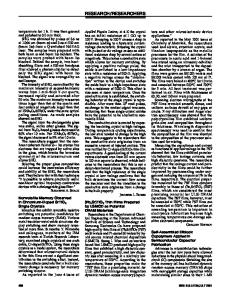Study of Chromium Impurities in SrTiO 3 by Photo-Electron Paramagnetic Resonance Spectroscopy
- PDF / 211,949 Bytes
- 6 Pages / 612 x 792 pts (letter) Page_size
- 56 Downloads / 307 Views
1034-K10-19
Study of Chromium Impurities in SrTiO3 by Photo-Electron Paramagnetic Resonance Spectroscopy Jamiyanaa Dashdorj, and Mary Ellen Zvanut Physics Department, University of Alabama at Birmingham, 1300 University Boulevard, Birmingam, AL, 35294 ABSTRACT Chromium impurities in SrTiO3 grown by Verneuil and Float-zone methods were investigated using photo-electron paramagnetic resonance spectroscopy. The samples are the substrates typically used for deposition of multifunctional and ferromagnetic films. A maximum optical cross section for Cr3+ of 2.6x10-18 cm2 is obtained from the time-dependent data, and steady state measurements suggest the presence of a defect level 2 eV from one of the band edges. The cross section is similar to that obtained from optical absorption studies of Cr3+ in semiconductors. The results produced here should be useful for those trying to interpret photoluminescence or similar optical characterization data.
INTRODUCTION Strontium titanate (STO) is an excellent substrate for heteroepitaxial growth of hightemperature superconductors and many oxide-based thin films [1, 2]. STO crystals have the perovskite structure, a dielectric constant of 300 at room temperature and band gap energy of 3.27 eV [3]. It is reported that SrTiO3 has an indirect band gap [3] in accordance with the band calculation and absorption measurements [4]. A broad photoluminescence band is observed in SrTiO3 at 2.4 eV under band-to-band excitation at low temperature [5, 6]. As with many complex oxides, transition metals and oxygen vacancies are common defects. Fe, Cr, and Mn are typical impurities detected in bulk crystals using optical absorption (OAS) or electron paramagnetic resonance (EPR) spectroscopy [7, 8]. Combination of OAS and EPR have been used to predict defect levels for several of the impurities, particularly the various charge states of Fe [9]. The unit cell of SrTiO3 consists of a central Ti4+ ion surrounded by six O2--ions. At the corners of the cube Sr2+ ions are situated, each with twelve O2 neighbors. The impurities typically replace Ti atoms and are often accompanied by creation of oxygen vacancies. Transition metals may enter the lattice unintentionally during growth or be incorporated intentionally in the melt or post-growth by metal evaporation. Despite the wealth of literature on defects in SrTiO3, there is little information about the optical response of the centers. Morin and Oliver combined thermally stimulated current measurements with EPR and OAS spectroscopies to study a series of defect levels of isolated Fe and Fe-oxygen vacancy complexes in SrTiO3 [10]. More recent work has employed luminescence, photoconductivity, and photo-EPR to study Cr3+ in pure SrTiO3 and SrTiO3 heavily doped with Ca [11]. The information from such studies is important to the interpretation of techniques such as cathodoluminescence, which serves as a convenient method to characterize thin film STO. Furthermore, understanding the defects in bulk material is increasingly important as SrTiO3 finds use as a suitab
Data Loading...










